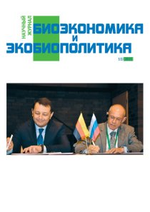Detection of Polycyclic Growth Arthrobotrys Longa, and the Study of its Connection with the Formation of a Complex of Proteolytic Enzymes
Авторы: Корниенко Е. И., Шаркова Т. С.
Рубрика: Тезисы
Опубликовано в Биоэкономика и экобиополитика №1 (1) декабрь 2015 г.
Дата публикации: 30.01.2016
Статья просмотрена: 17 раз
Библиографическое описание:
Корниенко, Е. И. Detection of Polycyclic Growth Arthrobotrys Longa, and the Study of its Connection with the Formation of a Complex of Proteolytic Enzymes / Е. И. Корниенко, Т. С. Шаркова. — Текст : непосредственный // Биоэкономика и экобиополитика. — 2015. — № 1 (1). — URL: https://moluch.ru/th/7/archive/20/688/ (дата обращения: 25.04.2025).
The strain of A. longa Mecht. 1 is a soil micromycete - nematofagin isolated from the soil of the Novosibirsk region with ability to secretion proteolytic enzyme complex Longolitin.
Longolitin is a complex of extracellular thrombolytic proteases with fibrinolytic and plasminogen activator activity. Such compositions are used extensively in medicine. They able to lyse clots, promoting human system of thrombolysis by activation of plasminogen protein in the bloodstream.
During the cultivation A. longa Mecht. 1 takes periodic change of generations: thin hyphae formed unicellular microconidia, which then form young hyphae. There were also marked fluctuations in production of longolitin. This picture may be associated with a change in the ratio of mycelial and conidial generations.
The study of the dynamics of production and accumulation of proteolytic enzymes A. longa 1 was carried out in submerged culture for 216 hours. Maximum plasmin-like and plasminogen activation activities occurred in the stationary growth phase. Maximum of plasmin-like activity was observed at 96 and 192 h of cultivation - 977 and 992 E/ml. Maximum of plasminogen activation activity occurred in 120 hours of culture, and was 481 E/ml. The accumulation of proteinase with plasmin-like and plasminogen activation activity of micromycetes A. longa 1 correlate with those of the specific growth rate. When it grows, and increasing the rate of synthesis of specific proteases. The findings suggest a polycyclic growth of this culture. This was confirmed by light microscopy.
We found the presence of A. longa 1 in submerged culture biorhythm endogenous sporulation with a period of 72 hours. It is also the maximum production of extracellular proteases with plasminogen activator to the activity observed at the time of germination of conidia and the formation of younger generations mycelium.







